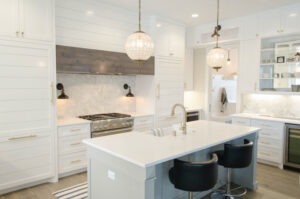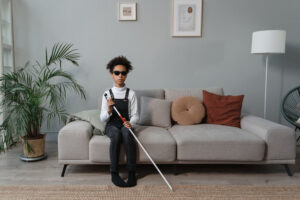
If someone with a visual impairment lives with you — or if you’re facing some level of blindness yourself — modifying your home makes it easier to navigate and safer to live in. Most modifications are simple, inexpensive changes that you can implement right away or over time, depending on your needs.
People with low-level blindness — which describes vision that’s 20/70 or poorer and can’t be corrected — can only read the first, second, or third line on the standard Snellen eye chart from 20 feet away. Those with legal blindness have a visual acuity of 20/200 or poorer when wearing corrective lenses, which means they can only read the first, giant letter on the eye chart — or they can’t. or their visual field — the total area you can see without moving your eyes — is 20 degrees or less, a condition known as tunnel vision.
People who have low-level or legal blindness — whether it’s moderate, severe, or profound — can still perceive light and shapes, even if they can’t make out what an object actually is. Total blindness, though, is a complete lack of light and form perception. Roughly 15 percent of all people with an eye disorder experience total blindness.
How you modify your home for someone with a visual impairment depends on how you live and the degree of impairment. These tips will help you cover all of the most important bases to ensure you or your visually impaired housemate can get around and locate things easily.
Home Modifications for Low Vision
Implement these changes in every room to make your home safer and easier to navigate.
Ramp Up the Lighting
Bring in lots of light — natural and artificial — to make things easier to see. Install task lighting where the most important activities take place, such as cooking and reading, and point the lights at the task, not the eyes. Use floor lamps, table lamps, or movable clip-on lamps for flexibility.
- Choose 60- to 100-watt bulbs for light fixtures.
- Create uniform lighting with as few shadows and dark spaces as possible.
- Experiment with different bulbs, from warm incandescent to cool fluorescent, to see which works best for your vision.
- Install adjustable blinds so that you can let the light in during the day.
- Set flashlights around key points throughout the house for times when you need a little extra concentrated light.
- Paint light switches in a bright, contrasting color.
Arrange the Furniture
Creating a smooth flow of traffic throughout the house helps prevent bumps and bruises resulting from running into furniture.
- Position mirrors so they don’t reflect bright lights.
Arrange your furniture to allow for wide pathways throughout your rooms. - Position a chair next to a window for natural light for reading or knitting.
- Choose furniture with differently textured upholstery so it’s easy to locate by touch.
Color Code and Label Household Items
Good home organization can prevent the need for labeling everything in the house. Always put things back where they belong when you’re done using them so you can find them easily. Color-coding and tactile labeling helps visually impaired residents find certain items around the house with ease.
For color-coding and tactile labels, use items like:
- Jumbo colored paper clips.
- Jumbo safety pins.
- Large fluorescent index cards — write on them with a thick, black marker.
- Colored electrical, masking, or duct tape.
Fabric paint. - Adhesive-backed gems.
- Adhesive-backed foam shapes.
- Large pipe cleaners.
- Rubber bands.
Eliminate Safety Hazards
Keeping your home free of general clutter and eliminating simple safety hazards improves the safety of people with vision loss.
- Use double-sided rug tape to secure the edges of your area rugs to the floor.
- Increase the visibility of the exits in the home with bright colors, exit lights, or contrasting colors.
- Use non-skid cleaners to clean your floors — avoid slippery waxes! — and keep the floors dry at all times.
- Make it a habit to push in all chairs when you’re done at your desk, the dining room table, or the breakfast bar.
- Secure electrical cords behind electronics, and keep them out of traffic routes.
- Install a hand railing on the stairs and grab bars in the shower and bathtub.
- Brightly light the stairways in the house, and paint or tape the edges of each step with reflective materials to keep them highly visible.
- Mark any other changes in floor level with bright, reflective colors.
- Replace smoke and carbon monoxide detector batteries twice a year, and develop and practice an evacuation plan so your visually impaired roommate can easily find their way out in an emergency.
Modifications For The Kitchen

Make the kitchen easy to use and navigate for your visually impaired housemate. Keep the countertops clear of clutter, and remove all obstacles in the room.
Swap out a shiny, slippery floor with a flooring material like rubber tiles, industrial low-pile carpet, or another non-slip surface.
- Paint the cupboard fronts in bright, contrasting colors to make it easy to find things.
- Keep a magnifying glass in a permanent spot in the kitchen to help identify canned foods and use the stove settings.
- Use a cutting board with a light side and a dark side for contrast no matter what you’re cutting.
- Install bright lighting under the counters for effective task lights.
- Apply a tactile sticker on the “medium” position of the burner dials and the oven controls.
- Purchase knives with sheaths to prevent cuts when reaching for them.
Modifications For The Bathroom
Bathroom modifications for the visually impaired should always include sturdy bars in the bath or shower and non-slip adhesive strips on the tub or shower floor. Set the water heater to 120 degrees Fahrenheit or lower to prevent accidental scalding.
Increase the wattage of light bulbs to brighten the bathroom.
- Use brightly colored towels that contrast with the walls to make them easy to find.
- Adjust the mirrors to prevent them from reflecting light.
- Re-paint high-gloss walls in an eggshell finish that won’t glare.
- Place bright nightlights in all of your bathrooms.
- Replace the white toilet seat with a colored one for increased contrast.
- Keep a thick rubber band around the shampoo bottle to differentiate it from the conditioner.
- Use a “soap on a rope” to keep it handy in the shower or bath and prevent it from falling on the shower floor.
- Use tactile stickers or rubber bands on toothbrushes, prescription medications, and other personal items to make identification easier.
Home Modifications for the Totally Blind

For people with total blindness, make the previously mentioned modifications for safety — tape the rugs, arrange the furniture, use tactile labeling, etc. Color and lighting changes won’t have an effect on someone with total blindness, since they can’t perceive light, color, or shape.
Use braille labels
Braille labels and labelers are available from specialty retailers, including handheld labelers, large, pre-cut container labels, magnetic can labels, tactile sock sorters, clothing tags, and more. Don’t forget to label poisons, prescription drugs, and other items that could be hazardous if accidentally swapped out for the wrong thing.
Install a Phone Entry System
An entry system that allows you to talk to people who come to your door is helpful for the blind and visually impaired, and some systems can even unlock the door so you don’t have to.
Install Safe Flooring
Slippery floors and loose carpeting are serious hazards for people with total blindness. Have your wood and tile floors coated with a non-slip overcoat, or install very low-pile, industrial-type carpeting that will prevent slips and trips. Use non-skid rugs for hard floors, and tape the edges down with double-sided tape.
Talking Devices
A range of talking devices can make life much easier for people with blindness or a visual impairment. A talking color identifier can recognize around 100 colors, which makes getting dressed easier. A voice labeling system lets you record your voice on special cards that can be attached to canned goods, clothes, medication, and other items. When you touch the label with the recording/playback device, the label will identify the object audibly.
Other talking devices for the blind and people with low vision include:
- Scales.
- Calculators.
- Blood pressure and glucose monitors.
- Thermometers for cooking, outdoor temps, and fever.
- Clocks and watches.
- Measuring tapes.
- Thermostat.
Other Helpful Devices for Low Vision and Total Blindness
In these modern times, there’s virtually nothing someone with impaired vision or total blindness can’t do, thanks to a multitude of low-vision household devices that make activities of daily living easier.
- Large-button, braille telephones.
- Cool-touch oven rack guards.
- Braille-labeled measuring cups and spoons.
- Cut-resistant gloves for chopping veggies.
- Appliances with tactile controls.
- Flexible food covers that seal any shape or size of bowl.
- A boiler alert that tells you when the water’s boiling.
- Large-print or braille keyboards.
If you’re bringing a service dog into your home, make sure the animal has a comfortable environment that includes a place to sleep in your bedroom and a designated spot for food and water. Also:
- Remove obstacles from hallways, such as tables or benches, to allow you both to pass through easily.
- Make sure your dog can hear you from all areas of the home — if not, get a dog whistle.
- Use raised food and water bowls to make them easier to fill.
- Make sure your houseplants are dog-friendly — some plants are toxic to dogs.
Creating a safe home environment for the visually impaired and totally blind is essential for their safety and wellbeing, but optimizing your home for someone with low or no vision is also about making their life easier. There’s no reason why people who have vision loss shouldn’t be able to do everything around the house a seeing person can do, and making it happen is a simple matter of implementing safety features and accessibility devices and taking the time to properly light the home, label its contents, and keep things where they belong.
Originally posted on Porch.com

